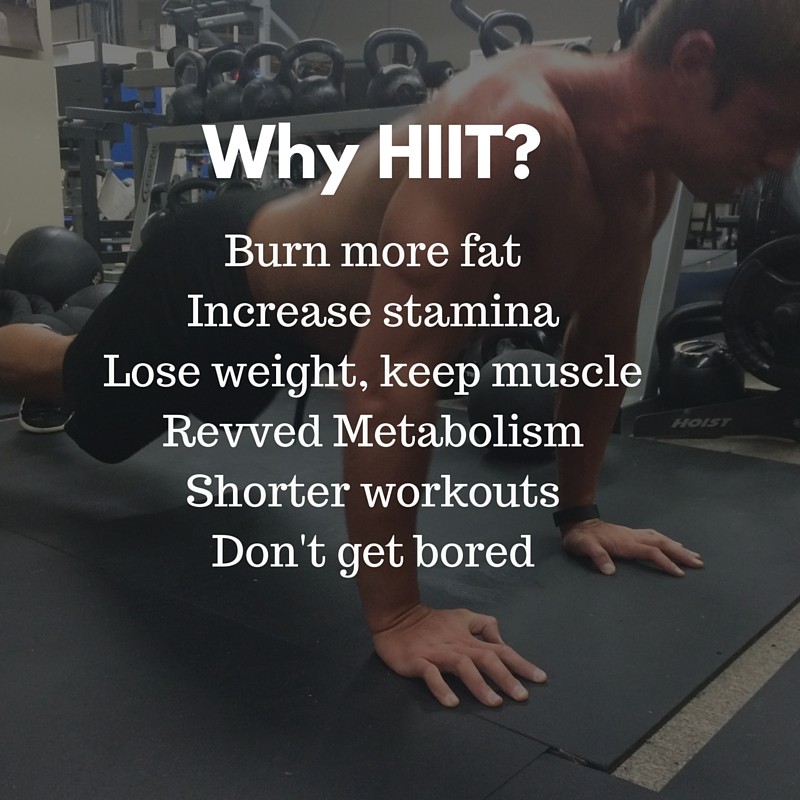3 Reasons Why this Former NFL Player Loves HIIT Training

There's a simple beauty in knowing that I can achieve a high level of fitness and a physique to match from doing 20 to 30 minute high-intensity interval workouts
a few times per week...
 Don't believe me? Read on.
Don't believe me? Read on.
Having been retired from the NFL for over three years now it's always fun to run into my former teammates. During pre-game of the NFL wild card round between the Packers and the Washington Redskins I crossed paths with Aaron Rodgers and we reminisced about old times.
The first thing he blurted out as he saw me was, "Wow! You look like you're in playing shape!" My response was, "Well, what were you expecting?” He responded by saying that he’s accustomed to seeing a lot of unfit, flabby bodies in the NFL locker room post-retirement.
After all, it’s not far-fetched for a retired NFL player to gain 50 to 60 pounds post-career since many continue to eat the same amount of calories without being able to burn them off as they did while playing in the NFL.
Many people, including former teammates, want to know what I’m doing to stay in "playing shape." They understand an NFL player's schedule has ample time for optimal training, but this is the opposite to life outside the NFL where finding time to workout is scarce.
[tweet_box float="right" width="50%" design="box_10"]My key for staying in “playing shape” involves quick 20-30 minute high intensity workouts[/tweet_box]My key for staying in “playing shape” involves quick 20-30 minute high intensity workouts. When compared to training three hours a day as a pro football player that's a dramatic time difference. It might be assumed that within those 20 to 30 minutes it would be hard for one to achieve the same type of fitness goals that would be possible in a three hour training session.
I’ve learned that if I optimize a 20 - 30 minute workout effectively I can achieve my fitness goals as if I had invested in a 3 hour training session like I used to as a NFL football player. Since beginning these 20 - 30 minute workouts over three years ago I’ve managed to get leaner without losing my muscle mass. I'm in better shape now and I'm managing to do so by getting more optimal training in less time per week compared to a single strength and conditioning session as an NFL player.
So, you might be thinking what's the basis behind effective 20 to 30 minute high intensity training sessions ?
When I look back at the three hour training sessions I did as an NFL football player a large portion of that time was dedicated to inactive rest periods. This basically means that you are either standing or sitting for several minutes at a time before your next set of exercises.
 Now instead of inactively resting during my workouts I practice an active resting period. This means that I alternate varying muscle groups, but my body as a whole is constantly on the move for the duration of the training session.
Now instead of inactively resting during my workouts I practice an active resting period. This means that I alternate varying muscle groups, but my body as a whole is constantly on the move for the duration of the training session.
To do this I divide up my exercises between pushing, pulling, and dynamic agility movements. When I am finished with a push movement I transition directly to performing a pull exercise and then on to a dynamic agility movement. So when I'm performing a push movement, I am resting my pulling muscles. Likewise when I transition to a pulling movement I now begin to rest my pushing muscles. I am resting and working at the same time, or as specified earlier, I am actively resting.
The purpose of the dynamic agility movement is to increase my heart rate in order to put my body into the most optimal metabolic state where I’m burning the highest amount of calories in the shortest amount of time. The result and benefit of constantly keeping my body on the move for the duration of the 20 to 30 minute workout session is that I’m now able to burn calories at a higher rate than if I were inactively resting for 2 to 3 minutes after each exercise.
Pull movements associated with the upper body work your biceps, scapular plane, lats, and traps. Some of those kinds of movements would be variations of rows, chin ups or pull ups, and lat pull-downs.
For the lower body your pulling muscles mostly involve your hamstrings and at times your glutes. Some lower body pulling movements would involve leg curls, single and double leg RDLs, and leg curls on the bosu ball.
[caption id="attachment_22256" align="aligncenter" width="650"] Additional Reading: 10 best exercises to keep you fit and healthy
[/caption]
Additional Reading: 10 best exercises to keep you fit and healthy
[/caption]
Upper body push movements would involve the chest, triceps and the front shoulder muscles. Lower body pushing muscles for the legs would primarily involve the calves and quads. Upper body pushing movements include variations of bench press, push-ups, shoulder press, and tricep extensions. Lower body pushing exercises would involve squats, lunges, leg extensions and leg raises.
Combining both pushing and pulling related movements improves symmetry and helps to keep your posture in a more stable and neutral position, thus taking stress off the lower back.
[box type="note" align="aligncenter" class="" width=""] Additional Reading: The usual excuse of " lack of time " for not doing enough exercise is blown away by new research. The study adds to the growing evidence for the benefits of short term high-intensity interval training (HIT) as a time-efficient but safe alternative to traditional types of moderate long term exercise. Astonishingly, it is possible to get more by doing less! [/box]
Some effective dynamic agility movements would include high knees, side shuffle, butt kicks, jumping jacks, and mountain climbers. These movements engage multiple muscle groups in a ballistic fashion leading to an increased heart rate.
I have come to love these compact, efficient, and portable 20 to 30 minute training sessions because staying in "playing shape" doesn't require a three hour a day workout. For many of us the greatest challenge of maintaining a consistent exercise routine is not having enough time or space. These quick and effective 20 to 30 minute sessions are an ideal solution to the time and space shortage dilemma.
http://youtu.be/HwIaQ_5SJ7I
[divider style="dashed" top="25" bottom="20"]
Brady played in the NFL for eight seasons (2005 to 2010 Green Bay Packers, 2011 St. Louis Rams and 2012 Dallas Cowboys). Brady is a member of the 2010 Green Bay Packers Super Bowl championship team. After retiring from the NFL over three years ago Brady has reinvented himself as an inventor of a revolutionary weightlifting machine , an entrepreneur starting up a company called Ultraflex Fitness LLC ( www.myultraflex.com ), a nationally recognized broadcaster (Fox Sports, Fox Deportes and Westwood 1 radio) and an author writing a book called the True Spirit of Competition.
Being bilingual, Brady made history by calling Super Bowl 48 in a pure Spanish production for the first time ever. Drawing from the training principles that he learned while playing football at the highest level, Brady has designed his own 20 to 30 minute high-intensity workouts. The fact that he's married, a father of four children, a fitness enthusiast and involved in many different ventures -- Quick, effective and fun workouts are essential in order for Brady to equally distribute his attention and energy in all aspects of his life.
[caption id="attachment_22236" align="aligncenter" width="618"] Brady: Then and Now[/caption]
Brady: Then and Now[/caption]
[divider style="dashed" top="25" bottom="20"]
 Don't believe me? Read on.
Don't believe me? Read on.Having been retired from the NFL for over three years now it's always fun to run into my former teammates. During pre-game of the NFL wild card round between the Packers and the Washington Redskins I crossed paths with Aaron Rodgers and we reminisced about old times.
The first thing he blurted out as he saw me was, "Wow! You look like you're in playing shape!" My response was, "Well, what were you expecting?” He responded by saying that he’s accustomed to seeing a lot of unfit, flabby bodies in the NFL locker room post-retirement.
After all, it’s not far-fetched for a retired NFL player to gain 50 to 60 pounds post-career since many continue to eat the same amount of calories without being able to burn them off as they did while playing in the NFL.
Many people, including former teammates, want to know what I’m doing to stay in "playing shape." They understand an NFL player's schedule has ample time for optimal training, but this is the opposite to life outside the NFL where finding time to workout is scarce.
[tweet_box float="right" width="50%" design="box_10"]My key for staying in “playing shape” involves quick 20-30 minute high intensity workouts[/tweet_box]My key for staying in “playing shape” involves quick 20-30 minute high intensity workouts. When compared to training three hours a day as a pro football player that's a dramatic time difference. It might be assumed that within those 20 to 30 minutes it would be hard for one to achieve the same type of fitness goals that would be possible in a three hour training session.
I’ve learned that if I optimize a 20 - 30 minute workout effectively I can achieve my fitness goals as if I had invested in a 3 hour training session like I used to as a NFL football player. Since beginning these 20 - 30 minute workouts over three years ago I’ve managed to get leaner without losing my muscle mass. I'm in better shape now and I'm managing to do so by getting more optimal training in less time per week compared to a single strength and conditioning session as an NFL player.
So, you might be thinking what's the basis behind effective 20 to 30 minute high intensity training sessions ?
3 Reasons to Adapt High Intensity Interval Training into your Lifestyle
#1. The Power Of Active Rest Periods
When I look back at the three hour training sessions I did as an NFL football player a large portion of that time was dedicated to inactive rest periods. This basically means that you are either standing or sitting for several minutes at a time before your next set of exercises.
 Now instead of inactively resting during my workouts I practice an active resting period. This means that I alternate varying muscle groups, but my body as a whole is constantly on the move for the duration of the training session.
Now instead of inactively resting during my workouts I practice an active resting period. This means that I alternate varying muscle groups, but my body as a whole is constantly on the move for the duration of the training session.To do this I divide up my exercises between pushing, pulling, and dynamic agility movements. When I am finished with a push movement I transition directly to performing a pull exercise and then on to a dynamic agility movement. So when I'm performing a push movement, I am resting my pulling muscles. Likewise when I transition to a pulling movement I now begin to rest my pushing muscles. I am resting and working at the same time, or as specified earlier, I am actively resting.
The purpose of the dynamic agility movement is to increase my heart rate in order to put my body into the most optimal metabolic state where I’m burning the highest amount of calories in the shortest amount of time. The result and benefit of constantly keeping my body on the move for the duration of the 20 to 30 minute workout session is that I’m now able to burn calories at a higher rate than if I were inactively resting for 2 to 3 minutes after each exercise.
#2. Combining Pushing And Pulling Movements For Symmetry
Pull movements associated with the upper body work your biceps, scapular plane, lats, and traps. Some of those kinds of movements would be variations of rows, chin ups or pull ups, and lat pull-downs.
For the lower body your pulling muscles mostly involve your hamstrings and at times your glutes. Some lower body pulling movements would involve leg curls, single and double leg RDLs, and leg curls on the bosu ball.
[caption id="attachment_22256" align="aligncenter" width="650"]
 Additional Reading: 10 best exercises to keep you fit and healthy
[/caption]
Additional Reading: 10 best exercises to keep you fit and healthy
[/caption]Upper body push movements would involve the chest, triceps and the front shoulder muscles. Lower body pushing muscles for the legs would primarily involve the calves and quads. Upper body pushing movements include variations of bench press, push-ups, shoulder press, and tricep extensions. Lower body pushing exercises would involve squats, lunges, leg extensions and leg raises.
Combining both pushing and pulling related movements improves symmetry and helps to keep your posture in a more stable and neutral position, thus taking stress off the lower back.
[box type="note" align="aligncenter" class="" width=""] Additional Reading: The usual excuse of " lack of time " for not doing enough exercise is blown away by new research. The study adds to the growing evidence for the benefits of short term high-intensity interval training (HIT) as a time-efficient but safe alternative to traditional types of moderate long term exercise. Astonishingly, it is possible to get more by doing less! [/box]
#3. Dynamic Agility Movements
Some effective dynamic agility movements would include high knees, side shuffle, butt kicks, jumping jacks, and mountain climbers. These movements engage multiple muscle groups in a ballistic fashion leading to an increased heart rate.
I have come to love these compact, efficient, and portable 20 to 30 minute training sessions because staying in "playing shape" doesn't require a three hour a day workout. For many of us the greatest challenge of maintaining a consistent exercise routine is not having enough time or space. These quick and effective 20 to 30 minute sessions are an ideal solution to the time and space shortage dilemma.
Here is an example of the different variations of one my high-intensity interval workouts:
http://youtu.be/HwIaQ_5SJ7I
[divider style="dashed" top="25" bottom="20"]
Author Bio: Brady Poppinga
Brady played in the NFL for eight seasons (2005 to 2010 Green Bay Packers, 2011 St. Louis Rams and 2012 Dallas Cowboys). Brady is a member of the 2010 Green Bay Packers Super Bowl championship team. After retiring from the NFL over three years ago Brady has reinvented himself as an inventor of a revolutionary weightlifting machine , an entrepreneur starting up a company called Ultraflex Fitness LLC ( www.myultraflex.com ), a nationally recognized broadcaster (Fox Sports, Fox Deportes and Westwood 1 radio) and an author writing a book called the True Spirit of Competition.
Being bilingual, Brady made history by calling Super Bowl 48 in a pure Spanish production for the first time ever. Drawing from the training principles that he learned while playing football at the highest level, Brady has designed his own 20 to 30 minute high-intensity workouts. The fact that he's married, a father of four children, a fitness enthusiast and involved in many different ventures -- Quick, effective and fun workouts are essential in order for Brady to equally distribute his attention and energy in all aspects of his life.
[caption id="attachment_22236" align="aligncenter" width="618"]
 Brady: Then and Now[/caption]
Brady: Then and Now[/caption][divider style="dashed" top="25" bottom="20"]




































































































